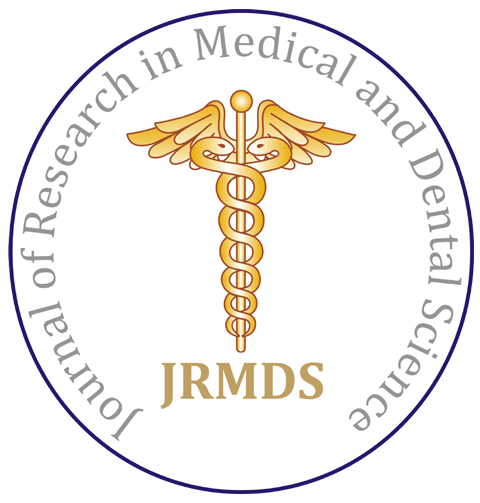Research - (2021) Volume 9, Issue 2
Knowledge, Attitude, and Practice about Sugar Substitutes and Oral Disorders among the Diabetic Patients
*Correspondence: Maragathavalli G, Department of Oral Medicine and Radiology, Saveetha Dental College and Hospitals, Saveetha Institute of Medical and Technical Sciences (SIMATS), Saveetha University Tamilnadu, India, Email:
Abstract
Aim: Diabetic patients are remarkably cautious about their health and lifestyle. Artificial sweeteners (AS) are food additives that mimic the effect of sugar in taste with less or no calories. This study aims to evaluate the knowledge, attitude, and practice of sugar substitutes among diabetic patients and the oral disorders related to it. Materials and method: A total of 100 diabetic patients were screened for a period of 4 months from September 2019 to December 2019. Individuals of the study were given a semi-structured questionnaire to fill in their knowledge, attitude, and practice about sugar substitutes and related oral disorders. Result: On analysis, it was discovered that 70% of the participants were aware of the existence of various brands of artificial sweeteners, 61% of them were aware of the health benefits and hazards and 39% weren’t aware. Conclusion: A large number of patients with diabetes were well known about the artificial sweeteners and the majority of them were under the impression that artificial sweeteners can also cause oral disorders.
Keywords
Artificial sweeteners, Attitude, Diabetic patients, Knowledge, Practice assessment
Introduction
According to the International Diabetes Federation (IDF), Diabetes is a chronic disease that arises when the pancreas does not produce enough insulin, or when the body cannot effectively use the insulin it produces. In 2017, it is found that approximately 463 million adults between the age group of 20-79 were present with diabetes, and by 2045, it is believed that there would be an increase to 700 million, with type 2 diabetes being the majority in the whole world [1]. It is reported that in India 61.3 million people were affected by diabetes till 2011 and it is estimated to rise to 101.2 million by 2030 [2]. As per the World Health Organization (WHO), India had 69.2 million people living with diabetes as per the 2015 data, of these, it remained undiagnosed in more than 36 million people [3].
In the current scenario, diabetic patients are remarkably cautious about their health and lifestyle. There has been a well appreciated and discernible rise in awareness among the general population about their health and fitness, thereby there is an exponentially increase in consumption of calorie deficit, sugar-free substitutes by the individuals [4].
Artificial sweeteners (AS) are food additives that mimic the effect of sugar in taste with less or no calories. Food Safety and Standards Authority of India (FSSAI) has approved 5 artificial sweeteners namely, saccharin sodium, aspartame, acesulfame potassium, sucralose, and neotame. They are generally several hundred to several thousand times sweeter than sucrose [5]. Each sweetener has specified characteristic features like sweetness intensity, taste, and the aftertaste effect [6]. However, consumption of these sweeteners may also aid in obesity, cardiac disorder, and so on in the long run.
Due to the change in lifestyle and rising urbanization, people are restrictive of their sugar intake in order to keep their blood glucose level under control and thus use artificial sweeteners as a substitute for normal sugar. Some sugar substitutes do release energy, however as they are slowly metabolized in the body, blood sugar levels remain relatively stable over a longer duration. However, sugar is the most acceptable sweetening agent in use by mankind which is considered as the “Arch Criminal” in the initiation of dental caries. Several other hard and soft tissue anomalies have been reported to be associated with diabetes in the oral cavity. They include periodontal diseases, salivary dysfunction leading to hyposalivation, delayed wound healing, and changes in the composition and pH of saliva, and taste dysfunction [7]. There are also reports of oral mucosal lesions in the form of stomatitis, benign migratory glossitis, fissured tongue, traumatic ulcer, lichen planus, lichenoid reaction, and angular cheilitis [4].
Oral physicians have the opportunity to educate the general public emphasizing on the diet and role of sugars which has the potential to cause various oral diseases. Familiarity with alternatives to sugars and the types of food products that are available with substitute sweetening agents are necessary, as the various forms of caries initiating sugars such as sucrose, glucose, fructose, and maltose continue to be actively sought for use in the food industry [8,9].
Hence, keeping in mind about the artificial sweeteners and oral disorders pertaining to diabetes a survey has been carried out among diabetic patients in order to assess the level of knowledge, attitude, and practice (KAP) about sugar substitutes and relative oral disorders. KAP survey is a simpler, well measurable, and effective study thus providing a vital research modality that brings an insight into a patient’s approach during clinical trials and other related studies. However, this study also aims to provide awareness about diabetes, artificial sweeteners, and its related oral disorders and educate them regarding the same. Our recent research portfolio slides numerous articles in reputed journals [10-14]. Based on this experience we planned to pursue the knowledge, attitude and practice about sugar substitutes and oral disorders among the diabetic patients.
Materials and Method
Study population
This was a cross-sectional study conducted among the diabetic patients attending the Outpatient Department of Saveetha Dental College and Hospital in Chennai from September 2019 to December 2019.
Ethical clearance
Before proceeding with the survey, the necessary ethical approvals were obtained from the institutional scientific review board (SRB/ SDC/OMEDI-001/01), and a signed consent form about the study was obtained from the patients.
Inclusion criteria
Diabetic patients who were under allopathy treatment, patients who had the knowledge, and currently use artificial sweeteners instead of normal sugar, and type 1 and type 2 diabetic patients were included in the study. Participants with the ability to understand and answer the asked questions alone were included in the study.
Exclusion criteria
Diabetic patients who were under Ayurvedic medicine, Siddha, or any other type of treatment other than allopathy were excluded. Patients who were not aware of artificial sweeteners or were found to be consuming jaggery powder, honey or another form of sweetener rather than commercially available artificial sweeteners were also excluded. Patients with h/o diabetes and who were pregnant or lactating were excluded from the study.
Description of the questionnaire
A pretested and semi-structured questionnaire was prepared and distributed which had both closed and open-ended questions. Questionnaires were shared among the participants in printed papers. The questionnaire had 20 questions to fill and keeping one min per question, a total of maximum of 20 minutes was allowed to be spared to fill the questionnaire. The questionnaire was in both English and the native language of the locality with simple and straightforward questions. The patients were given all the liberation to quit the survey whenever they wanted. Doubts, when possessed, were clarified by the researchers in the patient’s preferred dialect, and confidentiality of the participants’ identity and answers provided in the questionnaire were maintained strictly.
Sample size determination
A pilot study of the questionnaire was conducted on 20 participants to study the practicality and rationality before the commencement of the study and the prevalence rate was found to be 61.2%. Keeping the population size as infinite, we applied the formula for sample size N= z2pq/ d2, where z =1.96 keeping at 95% of level of confidence, p = 61.2% (determined from the pilot study), q =1- p (1- 0.5 = 0.5), d (precision rate) = 10%. The final sample size required for the study came out to be 100. Therefore, the study was conducted on 100 diabetic patients with the usage of artificial sweeteners.
Statistical analysis
Statistical analysis was carried out using SPSS v20.0 software. Descriptive and inferential statistical analysis has been carried out in the present study. Frequency distribution and percentage of the sociodemographic data of the study were also calculated. Significance is assessed at a 5% level of significance. Chisquare/ Fisher's exact test has been used to find the significance of study parameters between two or more groups.
Results
Out of 100 participants screened, 45% of the participants were female and the remaining 55% comprised of the male participants. Among these patients, the majority (32%) of the population lie between the ages of 51-60 years. The detailed demographic data of the study are described in (Table 1).
| Demographic data | Frequency | Percent | N | Mean | Std. Deviation | |
|---|---|---|---|---|---|---|
| AGE | 31-40 Years | 14 | 14 | 100 | 2.95 | 1.201 |
| 41-50 Years | 21 | 21 | ||||
| 51-60 Years | 32 | 32 | ||||
| 61-70 Years | 22 | 22 | ||||
| Above 70 Years | 11 | 11 | ||||
| GENDER | Female | 45 | 45 | 100 | 1.55 | 0.5 |
| Male | 55 | 55 | ||||
Table 1: Denotes the demographic data-age and gender of the study population.
Assessment of the knowledge of diabetes and artificial sweeteners
Of 100 participants, 39% of the population were present with diabetes for more than 5 years and only 18% of them were aware of the type of diabetes they were present with. 49% of them were found to be under insulin injections subcutaneously when 38% of them were taking oral hypoglycemic pills like metformin, glimepiride and 13% of them were using both injections and tablets. The majority of them got to know about artificial sweeteners through media like television, newspaper, and the internet. Of all, 70% of the population were aware of the various commercially available artificial sweeteners brands in the market (Table 2).
| Questions | Responses | Percent |
|---|---|---|
| 1. When were you diagnosed with diabetes? | ||
| Less than 5 years | 25 | 25 |
| More than 5 years | 39 | 39 |
| Less than 10 years | 21 | 21 |
| More than 10 years | 15 | 15 |
| 2. Which form of medications are you taking? | ||
| Tablet | 38 | 38 |
| Injection | 49 | 49 |
| Both | 13 | 13 |
| 3. Do you know what type of diabetes you have? | ||
| Yes | 18 | 18 |
| No | 82 | 82 |
| 4. How did you get to know about artificial sweeteners? | ||
| Doctor | 27 | 27 |
| Family/ Friends | 26 | 26 |
| Tv/ Internet/ Newspaper | 47 | 47 |
| 5. What type of artificial sweeteners do you use? | ||
| Tablet | 16 | 16 |
| Powder | 24 | 24 |
| Liquid | 27 | 27 |
| Chewing gums | 15 | 15 |
| All of the above | 18 | 18 |
| 6. Are you aware of the various brands of artificial sweeteners available in the market? | ||
| Yes | 70 | 70 |
| No | 30 | 30 |
Table 2: Reveals the assessment of the knowledge of diabetes and artificial sweeteners among the study population.
The association between the knowledge on artificial sweeteners and gender is revealed in Figure 1 which states 39% of the male and 22% of the female participants were aware of both the health benefits and drawbacks of consuming the artificial sweeteners. However, 39% of the population, 23% of females, and 16% of males were not aware of them.
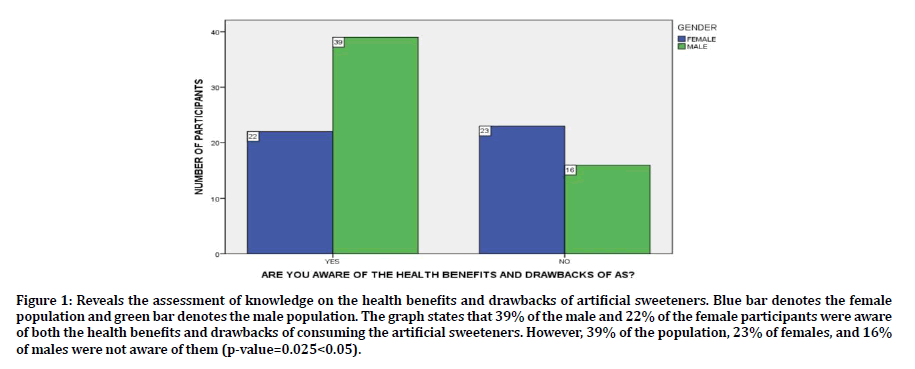
Figure 1. Reveals the assessment of knowledge on the health benefits and drawbacks of artificial sweeteners. Blue bar denotes the female population and green bar denotes the male population. The graph states that 39% of the male and 22% of the female participants were aware of both the health benefits and drawbacks of consuming the artificial sweeteners. However, 39% of the population, 23% of females, and 16% of males were not aware of them (p-value=0.025<0.05).
Assessment of the attitude towards artificial sweeteners and oral health
From Table 3 it is observed that 28% of them visit a dentist only if necessary or any dental emergency like tooth pain or swelling occurs. However, 10% of the population never visited a dentist so far and marked their first dental visit during the study period. It is understood that the main goal for the majority of the study population (46%) was to use artificial sweeteners to control their blood sugar level. 32% of the population believes that artificial sweeteners can also cause dental caries like normal sugar and 47% of the population even believe they also have the potential to cause gingival and periodontal diseases. On questioning regarding their salivary flow, 75% of them did not experience any changes like hyposalivation or xerostomia and 16% of them had reported occasional hyposalivation.
| Questions | Responses | Percent |
|---|---|---|
| 1. How often do you visit a dentist? | ||
| Regularly | 16 | 16 |
| Once in a year | 26 | 26 |
| Only if necessary | 28 | 28 |
| More than 10 years | 20 | 20 |
| Never | 10 | 10 |
| 2. Do you think that artificial sweeteners can affect oral health? | ||
| Yes | 61 | 61 |
| No | 39 | 39 |
| 3. Why do you use artificial sweeteners? | ||
| To control blood sugar level | 46 | 46 |
| As a substitute to normal sugar | 29 | 29 |
| Both | 25 | 25 |
| 4. Do you think artificial sweeteners can cause dental caries? | ||
| Yes | 32 | 32 |
| No | 57 | 57 |
| Maybe | 11 | 11 |
| 5. Do you think artificial sweeteners can cause gum problems/diseases? | ||
| Yes | 47 | 47 |
| No | 53 | 53 |
| 6. Have you ever had reduced salivary flow while on artificial sweeteners? | ||
| Yes | 9 | 9 |
| No | 75 | 75 |
| Sometimes | 16 | 16 |
Table 3: Reveals the assessment of the attitude of the study population towards artificial sweeteners and oral health.
The association between the craving for sweet based on gender was evaluated. On analyzing the answers to the intake during stressful times, 51% of the population did not have any cravings, while 33% of them on the other hand reported occasional cravings and increase in the frequency of using AS during stressful crises. 16% of the population did report having such frequent cravings (Figure 2).
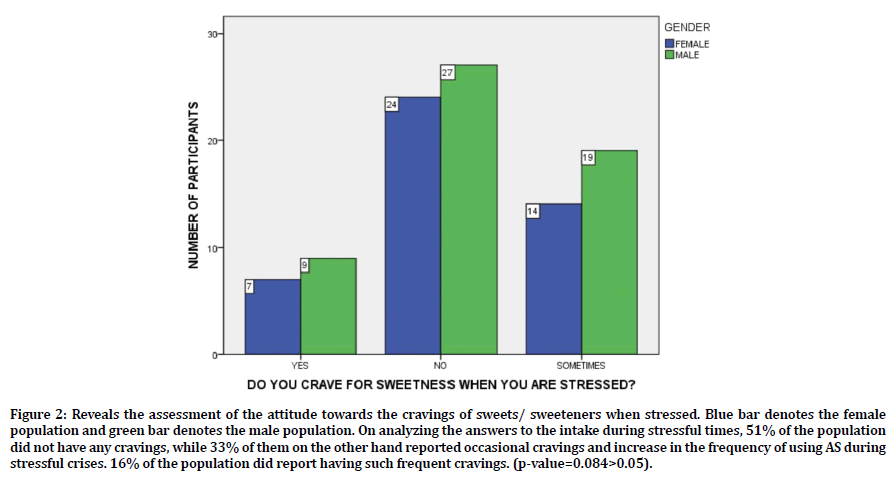
Figure 2. Reveals the assessment of the attitude towards the cravings of sweets/ sweeteners when stressed. Blue bar denotes the female population and green bar denotes the male population. On analyzing the answers to the intake during stressful times, 51% of the population did not have any cravings, while 33% of them on the other hand reported occasional cravings and increase in the frequency of using AS during stressful crises. 16% of the population did report having such frequent cravings. (p-value=0.084>0.05).
Assessment of the practice of using artificial sweeteners and concerning oral health
On questioning about the practical usage of artificial sweeteners, it is found that participants mainly used the AS in their beverages (41%). However, participants used AS in other forms like in cakes and pastries apart from beverages or other sweets. Participants were found to be preferring the tablet form of AS (29%) followed by liquid form (28%). 28% of the study population were denture wearers and 46.4% of those participants craved for sweetness occasionally while 28.6% of them had a constant craving for sweetness (Table 4).
| Questions | Responses | Percent |
|---|---|---|
| 1. In which food items do you commonly use artificial sweeteners? | ||
| Beverages | 41 | 41 |
| Sweets | 24 | 24 |
| Both | 27 | 27 |
| Others | 8 | 8 |
| 2. How much quantity of artificial sweeteners do you use? | ||
| 1-2 per day (Chewing gum) | 8 | 8 |
| 1-2 tsp per serving (Powder) | 24 | 24 |
| 1-2 tablets per serving (Tablets) | 29 | 29 |
| 1-2 drops per serving (Liquid) | 28 | 28 |
| 1-2 serving per day (Any of the above) | 11 | 11 |
| 3. Are you a denture wearer? | ||
| Yes | 28 | 28 |
| No | 72 | 72 |
| 4. If yes, do you crave for sweetness/sweeteners? | ||
| Yes | 8 | 28.6 |
| No | 7 | 25 |
| A little | 13 | 46.4 |
Table 4: Reveals the assessment of the practice of artificial sweeteners and oral health among the diabetic study population.
When the study population was questioned on when did they start on their artificial sweeteners it appears that 46% of them started immediately as soon as diagnosed with diabetes while 25% of the participants started after a few months to years later and 29% of them were already consuming artificial sweeteners even before diagnosed with diabetes (Figure 3). A figure is represented which graphically depicts the cumulative assessment of KAP levels that shows - knowledge (36.8%), attitude (36.8%), and practice (26.3%) (Figure 4).
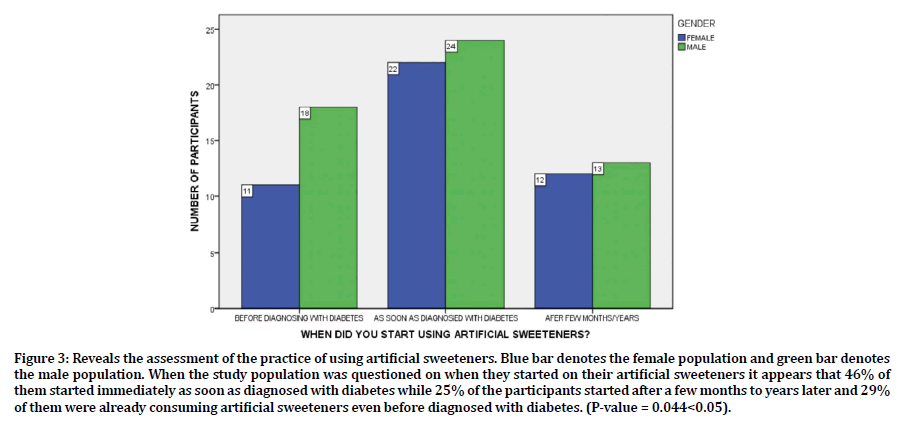
Figure 3. Reveals the assessment of the practice of using artificial sweeteners. Blue bar denotes the female population and green bar denotes the male population. When the study population was questioned on when they started on their artificial sweeteners it appears that 46% of them started immediately as soon as diagnosed with diabetes while 25% of the participants started after a few months to years later and 29% of them were already consuming artificial sweeteners even before diagnosed with diabetes. (P-value = 0.044<0.05).
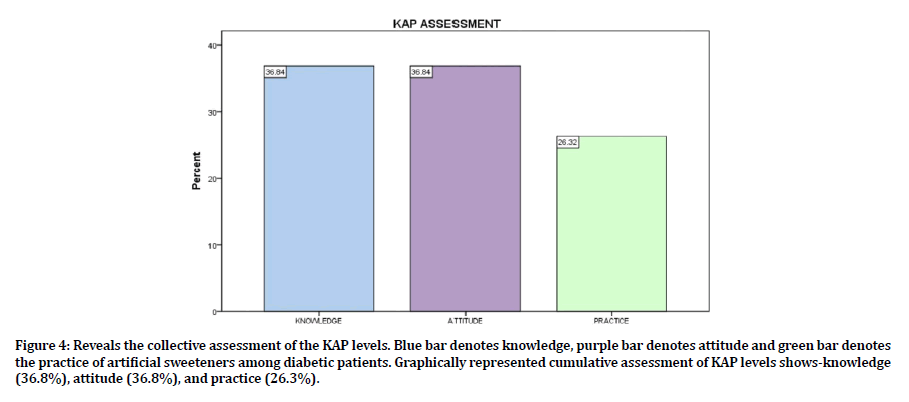
Figure 4. Reveals the collective assessment of the KAP levels. Blue bar denotes knowledge, purple bar denotes attitude and green bar denotes the practice of artificial sweeteners among diabetic patients. Graphically represented cumulative assessment of KAP levels shows-knowledge (36.8%), attitude (36.8%), and practice (26.3%).
Discussion
Artificial sweeteners have been widely used all over the world in many types of food to give them the sweet taste. At present, artificial sweeteners have not just been purchased by diabetic patients alone but also by the healthy individuals who aspire to modify their lifestyle. These sweeteners provide a sweet taste without affecting our blood glucose level and also aids in maintaining the weight.
On the assessment of the knowledge about diabetes and artificial sweeteners, it is inferred that the maximum of the respondents 39% were diabetic for more than 5 years. All these patients were allegedly to be under allopathy medications for diabetes. However, only 18% of them were aware of what type of diabetes they were present with and they were majorly present with type 2 diabetes mellitus. It was found during the study that 38% of them were under oral hypoglycemic drugs namely metformin, 49% of them were taking insulin injections subcutaneously and 13% of them were under both oral drugs and injection. On probing about the knowledge of artificial sweeteners, the maximum number of participants revealed that they were influenced by the media (47%). On further questioning the participants about the artificial sweeteners, it is inferred that enough knowledge of the health benefits and hazards (61%) and on various brands (70%) of the artificial sweeteners were evident among the study population.
It is stated that the participants believe that diabetes and oral disorders are interrelated, and 61% of them even believed that artificial sweeteners can also cause oral diseases. They were under the impression that the usage of artificial sweeteners can help them from controlling diabetes and maintaining the blood glucose level as the natural sugars failed in those and 29% of the population used it as a substitute for natural sugars. Furthermore, questions related to oral diseases like dental caries, gingival and periodontal diseases, salivary dysfunction were asked to check their attitude towards oral health.
Xylitol is one of the most widely used artificial sweeteners. Field studies on xylitol carried out in Russia, Hungary, and Estonia have proven that xylitol is a non cariogenic sweetener [15] Clinical trials of xylitol in chewing gums have also been conducted and have proven that the use of xylitol helps in the prevention of dental caries [16-19]. Besides these chewing-gum based clinical trials, there is also clinical evidence that xylitol candies are as effective as xylitol gum in caries prevention and they are prone to be economically feasible as well [20]. In our study, 15% of the study population was consuming chewing gums made of xylitol. Since xylitol is a bulk sweetener, it can induce osmotic diarrhea in children under 3 years of age, and hence it is contraindicated. However the bulk sweeteners like xylitol, sorbitol are caloric agents while the intense sweeteners namely aspartame, saccharin, sulfamate are noncaloric [21].
On questioning the participants on their take on gingival/ periodontal diseases caused by artificial sweeteners, 47% of them believed that AS has the potential to cause gingival diseases. Various researches have proven to show that intense sweeteners like saccharin, aspartame, sucralose tend to have antimicrobial properties. An in-vitro study conducted in India based on commercially available intense sweeteners has proven to be effective in acting against bacterias like P. gingivalis and A. actinomycetemcomitans [22]. Allegations on increase in the salivary flow have been made after using AS which can act as a stimulant in protecting dental caries and plaque accumulation. However, the plaque pH value has been shown to correlate with the salivary flow which is induced by the foods (sugar-coated and non-sugar coated) and proven to have a plaque washing effect after consumption of non-sugar coated foods [9]. Based on the allegation, the participants were asked about hyposalivation and it is found that 75% of them had normal salivary flow and 9% of them claimed that they have a decreased salivary flow. Evidence has shown that uncontrolled diabetes can cause oral manifestations like periodontal diseases, hyposalivation, and xerostomia. However, there are possibilities for the general population to misinterpret the actual cause of periodontal anomalies and hyposalivation.
Leon Festinger, a psychologist, proposed a theory on ‘cognitive dissonance’. He states that cognitive dissonance refers to a situation involving conflicting attitudes, beliefs, or behaviors which produce a feeling of mental discomfort leading to mental stress [23]. Behavioral research on users of artificial sweeteners may be needed in order to understand the etiology, whether the individual is stressed? subjected to cognitive dissonance? Or is it possible that a taste-deficiency is needed for recognition, for triggering the release of stress or guilt feelings? Based on these hypotheses, our study participants were questioned on their cravings for sweetness during stressful crises, and it appears to be only 16% of them had severe cravings and 33% of them had occasional cravings during stressful situations. The majority of the participants did not have any such cravings.
On assessing the practice of the diabetic patients, it is observed that 28% of them were denture wearers. The common complaint said by denture wearers next to difficulty in eating, is the inability of food recognition. The artificial sweeteners manufacturing industries are acutely aware of the interaction of sweetness with the organoleptic properties and strive to put out a set of balanced materials [24]. With the denture wearers, the balance point would be inappreciable for numerous food items, and they may attempt to restore it by returning to the only readily available flavor stimulants i.e., majorly salt and sweet [9]. Increased sweet consumption may be of a general health concern even beyond oral health. 28.6% of the population agreed to have cravings for sweetness and 46.4% of the population encountered occasional cravings.
The current cross-sectional study was conducted in a hospital-based setup with participants visiting the OP who were found to be diabetic. Many studies and surveys have shown that long term use of artificial sweeteners can cause health hazards like obesity, diabetes mellitus, cancer, etc [25,26]. However, the oral hazards as such caused by artificial sweeteners are found to be minimal and less proven.
Conclusion
Deficient knowledge, indifferent attitude, and inappropriate practice regarding the usage of artificial sweeteners have been observed predominantly among the male participants. Irrespective of the clinically proven criteria about the general health hazards of artificial sweeteners, the participants lacked a sound knowledge on it. The patients knowledge about the related oral health was found to be average. Irrespective of 61% of the population claiming to have knowledge about AS, 30.8% of them believed dental caries can be caused by AS and 45.2% of them even believed periodontal diseases can occur. It is evident that the participants were not fully aware of AS and oral health. Misinterpretation between diabetes-related oral disorders and artificial sweeteners related oral disorders were clearly evident. Hence, emphasizing the need to promote awareness on controlling diabetes, about visiting a dentist twice a year and educating them about artificial sweeteners in order to prevent any appalling long term general and oral health complications related is important.
Clinical Significance
Diabetic patients are commonly encountered in dental practice. Artificial sweeteners are widely used by the general public all over the world, especially by the diabetic patients. Oral disorders caused by artificial sweeteners are at negligible amount and it is a duty of the dentist to educate them regarding the diseases caused due to uncontrolled diabetes and emphasize in good oral hygiene practice.
Acknowledgement
The authors of this article would like to thank Saveetha Dental College and Hospital, Saveetha Institute of Medical And Technical Sciences, Chennai.
References
- https://www.idf.org/aboutdiabetes/what-is-diabetes/facts-figures.html
- Haas DA. Management of medical emergencies in the dental office: conditions in each country, the extent of treatment by the dentist. Anesth Prog. 2006; 53:20–24.
- Saxena K, Sharma ML, Vijay B, et al. Knowledge, attitude and practice assessment of dental professionals towards diabetes: A cross sectional study. J Dent Specialities 2016; 4:113–118.
- Mr RN, Jain R. Knowledge, attitude and practice of diabetic patients regarding the use of artificial sweetners as substitute to sugar. Natl J Integr Res Med 2018; 9.
- Fujimaru T, Park JH, Lim J. Sensory characteristics and relative sweetness of tagatose and other sweeteners. J Food Sci 2012; 77:323–328.
- Patil S, Ravi R, Saraswathi G. et al. Development of low calorie snack food based on intense sweeteners. J Food Sci Technol. 2014; 51:4096–4101.
- Al-Maskari AY, Al-Maskari MY. Oral manifestations and complications of diabetes mellitus: A review. Sultan Qaboos Univ Med J 2011; 11:179.
- Roberts MW, Wright JT. Food sugar substitutes: A brief review for dental clinicians. J Clin Pediatr Dent 2002; 27:1–4.
- Roshan NM, Sakeenabi B. Practical problems in use of sugar substitutes in preventive dentistry. J Int Soc Prev Community Dent 2011; 1:1–8.
- Subramaniam N, Muthukrishnan A. Oral mucositis and microbial colonization in oral cancer patients undergoing radiotherapy and chemotherapy: A prospective analysis in a tertiary care dental hospital. J Investig Clin Dent 2019; 10:12454.
- Vadivel JK, Govindarajan M, Somasundaram E, et al. Mast cell expression in oral lichen planus: A systematic review. J Investig Clin Dent 2019; 10:e12457.
- Patil SR, Maragathavalli G, Ramesh DNSV, et al. Assessment of maximum bite force in oral submucous fibrosis patients: A preliminary study. Pesqui Bras Odontopediatria Clin Integr 2020; 20:482.
- Patil SR, Maragathavalli G, Araki K et al. Three-rooted mandibular first molars in a Saudi Arabian population: A CBCT Study. Pesqui Bras Odontopediatria Clin Integr 2018; 18:4133.
- Patil SR, Yadav N, Al-Zoubi IA. et al. Comparative study of the efficacy of newer antioxidants lycopene and oxitard in the treatment of oral submucous fibrosis. Pesqui Bras Odontopediatria Clin Integr 2018; 18:1–7.
- Mäkinen KK. The rocky road of xylitol to its clinical application. J Dent Res 2000; 79:1352–1355.
- Scheinin A, Mäkinen KK. Turku sugar studies: An overview. Acta Odontologica Scandinavica. 1976; 34:405–408.
- Isokangas P, Alanen P, Tiekso J. et al. Xylitol chewing gum in caries prevention: A field study in children. J Am Dent Assoc 1988; 117:315–320.
- Kandelman D, Gagnon G. A 24-month clinical study of the incidence and progression of dental caries in relation to consumption of chewing gum containing xylitol in school preventive programs. J Dent Res 1990; 69:1771–1775.
- Makinen KK, Bennett CA, Hujoel PP. et al. Xylitol chewing gums and caries rates: A 40-month cohort study. J Dent Res 1995; 74:1904–13.
- Alanen P, Isokangas P, Gutmann K. Xylitol candies in caries prevention: results of a field study in Estonian children. Community Dent Oral Epidemiol 2000; 28:218–224.
- Gupta P, Gupta N, Pawar AP. et al. Role of sugar and sugar substitutes in dental caries: A review. ISRN Dent 2013; 519421.
- Prashant GM, Patil RB, Nagaraj T. et al. The antimicrobial activity of the three commercially available intense sweeteners against common periodontal pathogens: An in vitro study. J Contemp Dent Pract 2012; 13:749–752.
- McLeod S. Cognitive dissonance. Simply Psychol 2008; 31:2–7.
- Rajky-Medveczky G, Takács-Palásti M, Bolla-Pusztai E, et al. Organoleptic study of a new dihydrochalcone artificial sweetener. Nahrung 1977; 21:131–137.
- Sadiq MA, Salih AA. Knowledge and attitude about sweeteners among type 2 diabetic patients. Archives Internal Med Res 2018; 1:1–5.
- Saito T, Pereira RB, Paixao MPCP. Assessment of the level of knowledge of diabetes mellitus patients about sweeteners/Avaliacao do nivel de conhecimento de portadores de diabetes mellitus sobre adocantes. Demetra Food Nutrition Health 2013; 8:39.
Author Info
Department of Oral Medicine and Radiology, Saveetha Dental College and Hospitals, Saveetha Institute of Medical and Technical Sciences (SIMATS), Saveetha University Tamilnadu, Chennai, IndiaCitation: Indra G, Maragathavalli G Knowledge, Attitude, and Practice about Sugar Substitutes and Oral Disorders, J Res Med Dent Sci, 2021, 9 (2): 321-329.
Received: 23-Sep-2020 Accepted: 15-Feb-2021
